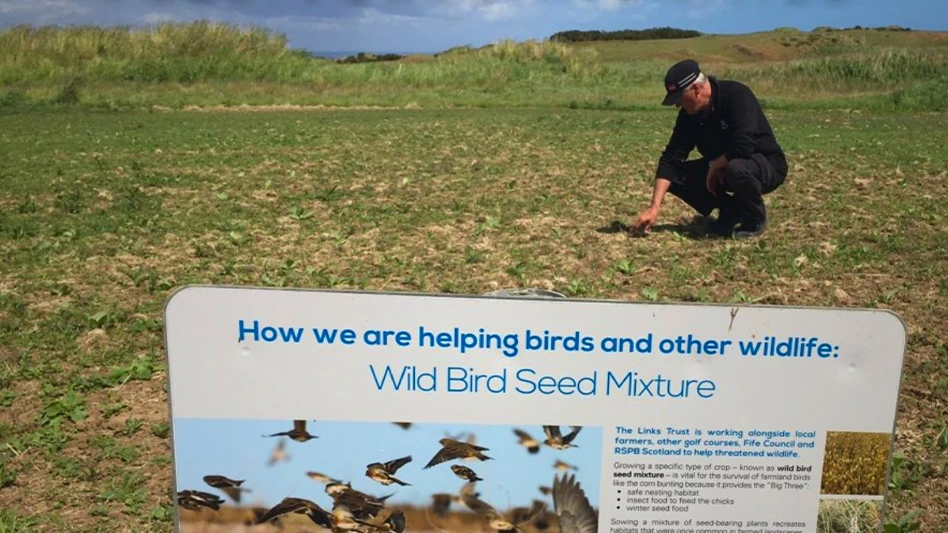The debate about how to combat fungicide resistance continues. While a number of plant pathologists advocate rotating chemicals, some take the opposite position. As an example, three golf course superintendents in Orlando have never used the same material in consecutive applications. While admitting they haven’t scientifically documented the rationale for their programs, each says chemical rotation is what they were taught. And during their many years in the business, this principle has proven effective for them.
|
|
Fungicide resistance is defined as the emergence of a target pathogen population that isn’t sufficiently sensitive to be controlled adequately by a fungicide that was effective previously. Once a pathogenic fungus develops resistance, a disease can get out of control quickly despite fungicide use, even with frequent applications at high rates.
There are two types of resistance:
• Single-step resistance is a sudden, marked decrease of effectiveness. Increasing the application rate doesn’t matter because this resistance is stable and can last for many years. This occurs in benzimidazoles, strobilurins, dicarboximides and phenylamides.
• Multi-step resistance is less sudden, and there’s a gradual decrease of sensitivity to the fungicide. This is less stable and occurs in products such as sterol inhibitors (DMIs).
And there’s another event: cross-resistance, which occurs in chemically related fungicides that have the same biochemical mode of action such as strobilurins, sterol inhibitors and dicarboximides.
|
|
Fungicide resistance is caused by a naturally occurring random mutation in the fungus that allows it to grow and reproduce in the presence of a fungicide. The mutation might result in the alteration of the biochemical target site in the plant, development of an alternative metabolic pathway, metabolic breakdown of the fungicide and exclusion or expulsion of the fungicide.
Other fungicide resistance elements are:
• The fungicide didn’t cause the mutation – it selects for pathogens with mutation;
• Many mutations don’t have any effect – some are lethal to the organism;
• It’s estimated that one in every one billion spores or propagules is resistant to a fungicide;
• Resistance usually isn’t noticed until about one in 50 pathogen individuals is resistant; and
• Resistance is a shift in the pathogen population.
It’s critical to note most fungicides don’t kill fungi. Continual use of a single fungicide family selects fungi that are resistant to it. In fact, the proportion of resistant individuals in the population increases.
|
|
Management strategies
The Fungicide Resistance Action Committee is a specialist technical group of CropLife International. Its purpose is to provide fungicide resistance management guidelines to prolong the effectiveness of at-risk fungicides and to limit crop or turf losses should resistance occur. The goal of FRAC is to identify existing and potential resistance problems. It collates information and distributes it to groups involved with fungicide research, distribution, registration and use. FRAC provides guidelines and advice on the use of fungicides to reduce the risk of developing resistance and to manage resistance should it occur. The organization recommends procedures for use in fungicide resistance studies and stimulates an open liaison and collaboration with universities, government agencies, advisors, extension workers, distributors and farmers.
FRAC suggests the following strategies for resistance management.
1. Don’t use the product in isolation. Rotate chemical families. Apply products as a mixture with one or more fungicides of a different type, or as one component in a rotation or alternation of different fungicide treatments.
2. Restrict the number of treatments applied per season and apply only when strictly necessary. Use other fungicides subsequently. This approach, like rotation, reduces the total number of applications of the at-risk fungicide, and therefore, must slow down selection to some extent. It can also favor decline of resistant strains that have a fitness deficit. However the treatments, which are still applied consecutively, generally coincide with the most active stages of epidemics when selection pressures are highest. Thus, any delay in resistance might not be proportional to the reduction in spray number. On the other hand, a substantial break in use at a time when the pathogen is still multiplying can allow a beneficial resurgence of more sensitive forms.
|
|
4. Avoid eradicant use. One of the advantages of systemic fungicides is they can eradicate or cure infections. This property greatly assists their use on a threshold basis where application is made only when an economically acceptable amount of disease already has appeared to prevent further spread. However, avoidance of systemic fungicide use in this way is recommended as an anti-resistance strategy.
5. Integrated disease management or integrated pest management. The integrated use of all types of countermeasures against disease is desirable on economic and environmental grounds and is a major strategy for avoiding or delaying fungicide resistance.
6. Chemical diversity. The availability of a number of different fungicides for the control of each major disease is highly beneficial environmentally and to overcome resistance problems. The continued use of one or few types of compounds throughout many years presents a much greater risk of side effects and favors resistance in the target organisms. Tank mix or alternate at-risk fungicides with appropriate fungicides.
|
Dissenting opinion |
|
Not everyone agrees rotating chemicals combats fungicide resistance. Perhaps the most outspoken about this position is J.M. Vargas Jr., Ph.D., a professor in the plant pathology department at Michigan State University. Vargas conducted research on fungicide resistance management for dollar spot fungus (Sclerotinia homoeocarpa). The key points of the study were: |
• Keep spray equipment calibrated;
• Spray preventatively when possible; and
• Use synergistic combinations. Synergism is the cooperative action of two agrochemicals such that the observed response of a test organism to their joint application appears to be greater than the response predicted to occur by an appropriate reference model. The late Dr. Houston Couch of Virginia Tech University concludes various disease management strategies could significantly modify the inherent risk of fungicide resistance in the target pathogen. He also says risk could be lowered by rotation among fungicides with different biochemical modes of action or by using synergistic fungicide combinations.
Practicing rotation
Three superintendents in the Orlando, Fla., area always have rotated fungicides.
At Grand Cypress Golf Club, the fungicide program for the 48-hole facility includes 21- to 28-day intervals from October to January. Superintendent Tom Alex rotates systemic and contact products, broad spectrums and pythium – whatever is necessary.
“I have never, ever given fungicides a chance for resistance because I’m always switching,” he says. “I might use five to seven different products and never go with them in back-to-back applications. There are enough different materials out there that give decent disease control.”
Alex never sprays one product until it doesn’t work anymore.
“Call it old school thinking, but in my opinion, why not keep four or five different fungicides in your arsenal that work versus using only one and everything eventually becomes resistant to it,” he says. “Now I’m down to four choices. Use another one up, and I’m down to three choices. The heck with that. I want as many choices as I can get. I haven’t seen any evidence that not rotating is a better option. I don’t have any reason to believe what we’re doing is not working.”
John Anderson, superintendent at Arnold Palmer’s Bay Hill Club, also rotates between systemic (usually single site) and contact (usually multisite) products because they work in different ways.
“Systemics go into the plant and work very well to prevent disease,” he says. “Contacts stick to the outside of the plant, and while they don’t last very long, their base of activity is much broader. With a product with a narrow base of activity, it’s more likely that resistance will develop. With a broad-based product that attacks disease from all directions, it’s almost impossible to develop resistance. It’s important to have both types of products in our rotation.”
Anderson uses at least seven different fungicides on the TifEagle Bermudagrass greens.
“If there is a disease present, and we use the same material all the time, the pathogen builds a resistance against the fungicide,” he says. “I haven’t done my own scientific research, but this is what I’ve been taught, and it works.”
Superintendent Rickey Craig of Shingle Creek Golf Club believes in preventative maintenance when it comes to fungicides. He closely monitors weather conditions because each soil-borne disease organism prefers a specific growing environment.
“I’m a minimalist as much as possible when it comes to fungicides,” he says. “Of course I make adjustments when I see a problem, and I always alternate products. As one product is used, I bring another in for the next application. The goal is not to go back-to-back. The bottom line with fungicides – rotating material works, so that’s why we do it.” GCN
David Wolff is a freelance writer based in Watertown, Wis. He can be reached at dwolff@charter.net.

Explore the May 2005 Issue
Check out more from this issue and find your next story to read.
Latest from Golf Course Industry
- The Aquatrols Company adds former superintendent to its R&D team
- Heritage Golf Group expands into Tennessee
- Making the grade — at or near grade
- PBI-Gordon receives local business honor
- Florida's Windsor takes environmental step
- GCSAA names Grassroots Ambassador Leadership Award winners
- Turf & Soil Diagnostics promotes Duane Otto to president
- Reel Turf Techs: Ben Herberger









